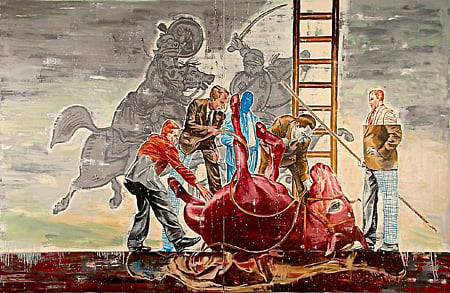Galleries
Gallery Opening: An Interview with Taymour Grahne
Caitlin Parker interviews Taymour Grahne, of Taymour Grahne Gallery in New York.

Caitlin Parker interviews Taymour Grahne, of Taymour Grahne Gallery in New York.

Caitlin Parker: What type of art does your gallery focus on?
Taymour Grahne: Taymour Grahne Gallery is focused on an international roster of Contemporary artists, with a strong number of artists from the Middle East and North Africa and its diaspora.
CP: How many artists do you represent? Can you tell us about a few of them?
TG: The gallery has a growing roster of artists, and we collaborate with a select group of artists to present solo show in New York City. We currently represent six artists, including three artists who represented their nations at this year’s Venice Biennale: Tarek Al Ghoussein (Palestinian, b.1962), who represented Kuwait; Mohammed Kazem, a leading Emirati conceptual artist representing the UAE; and Camille Zakharia (Lebanese, b.1962), who represented Bahrain. Tarek’s works that were present were those from his K-files series where the artist photographed and interacted with specific sites significant to the development of Kuwait as a modern state. Kazem’s encompassing 360-degree video and sound installation transported the viewer into the deep sea. The lack of a geographical reference point and the inclusion of GPS coordinates highlight the symbolic breakdown of today’s geopolitical borders.
Nicky Nodjoumi (b.1942) is an Iranian American with whom I opened the gallery. Nicky is a master political artist, whose figurative paintings engage in political discourse with a light, satirical touch. His works often incorporate historical Iranian references with be-suited political Western figures, these characters interacting in a stage-like manner, and his works have often been compared to theatrical stages.
CP: How do you select the artists that you represent?
TG: I am interested in artists who engage with both historic and socio-political references in their work, and who are interested in all types of media.
CP: Can you tell us about your current show?
TG: Our current show is a solo show by Iranian artist Reza Derakshani(Iranian, b.1952), titled My Wicked Persian Carpet. This exhibition is split onto the gallery’s two floors: on the lower level, Reza has painted new works as a continuation from his miniature series, where he takes inspiration from Persian miniatures and beautifully paints them in a more abstract manner. On the upper floor, Reza’s works include his skulls.
CP: What is your next important show? Tell us why we should come.
TG: Our next show is a solo exhibition by the young Irish artist Ciarán Murphy, titled A Round Now. This will be Ciarán’s first solo in New York, and will feature a selection of new oil paintings and watercolors. Ciarán’s work is archival—his paintings’ starting points come from a wide-ranging selection of images found, collected, and carefully arranged into categories by the artist over the years.
CP: What future development plans do have for your gallery?
TG: We will be launching our first monograph, in collaboration with Black Dog Publishing, of one of the gallery’s artists Tarek Al Ghoussein in the fall of 2014 during his solo show. We are also planning some very exciting public program events and lectures.
CP: Have you noticed a trend in the origin of your buyers?
TG: Our collectors are mainly American or New York-based, but we also have some great clients in Europe and the Middle East.
CP: Do you think attending art fairs is crucial to gaining exposure as a gallery? If so, which fairs are you participating in this year?
TG: Definitely. Art fairs are a crucial component of any gallery’s programs in today’s art world. Art fairs are a great way to meet new collectors, and are also a chance to show some new works by a variety of the gallery’s artists.
CP: How has the Internet influenced the dynamic of your business?
TG: The Internet has played a significant part in granting exposure for galleries. Through gallery websites—sites such as artnet, and online art news sites such as GalleristNY—one is able to stay up to date with all the goings on in the art world.
CP: What do you use artnet for? How frequently do you use it?
TG: I use artnet primarily for looking up artists’ auction prices. I use it a few times a week. It is a very useful tool, especially for the secondary market.
CP: What advice would you give to a first-time collector?
TG: Make a point to visit many galleries, and research the artists you like before buying. And most importantly, buy what you love!
CP: Are there any exhibitions at the moment that you would recommend?
TG: Lehmann Maupin’s Chrystie Street gallery has a beautiful exhibition by Shirazeh Houshiary (Iranian, b.1955), and I very much look forward to visiting Pace for the Raqib Shaw (Indian, b.1974) solo exhibition in New York City.